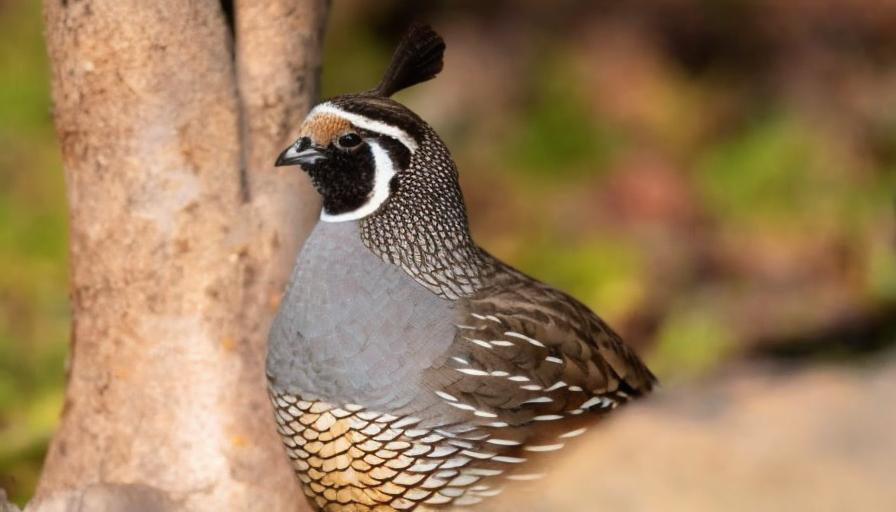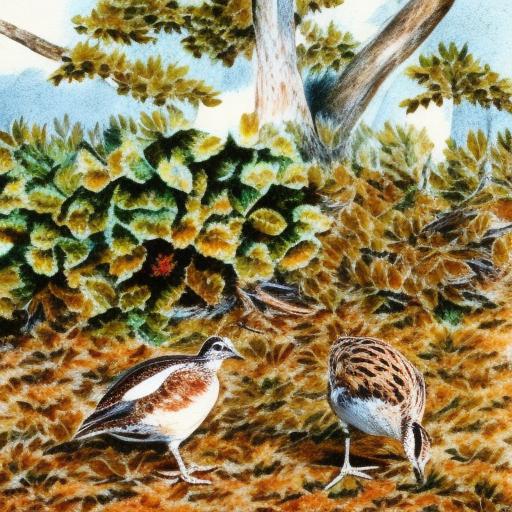Colony breeding is a method of breeding animals, such as bobwhite quail, in a communal setting rather than in individual pairs. This approach allows for natural social interactions and behaviors to occur, which can lead to improved breeding success and overall health of the quail. In a colony breeding program, multiple males and females are housed together in a large, naturalistic environment that mimics their natural habitat. This method of breeding has gained popularity in recent years due to its potential benefits for the welfare and productivity of the quail.
Colony breeding offers a more natural and less stressful environment for bobwhite quail, as it allows them to exhibit their natural social behaviors and hierarchies. This can lead to improved breeding success, as the quail are able to form strong pair bonds and engage in natural courtship behaviors. Additionally, colony breeding can result in higher fertility rates and increased egg production, as the quail are able to mate more freely and frequently. Furthermore, colony breeding can help to maintain genetic diversity within a population, as it allows for more natural mate selection and reduces the risk of inbreeding. Overall, colony breeding has the potential to improve the overall health and welfare of bobwhite quail while also increasing the productivity of a breeding program.
Key Takeaways
- Colony breeding involves keeping a group of quail together for natural breeding and rearing of offspring.
- Colony breeding can lead to increased genetic diversity and better adaptation to local environments for bobwhite quail.
- A successful colony breeding program requires proper habitat, predator control, and monitoring of population dynamics.
- Managing the health and nutrition of bobwhite quail in colony breeding involves providing a balanced diet and regular health checks.
- Breeding and incubation of bobwhite quail eggs in a colony setting requires providing suitable nesting sites and monitoring egg viability.
Benefits of Colony Breeding for Bobwhite Quail
Colony breeding offers several key benefits for bobwhite quail compared to traditional pair breeding methods. One of the primary advantages of colony breeding is the promotion of natural social behaviors and hierarchies within the quail population. In a colony setting, quail are able to form strong pair bonds and engage in natural courtship behaviors, which can lead to improved breeding success and higher fertility rates. Additionally, colony breeding allows for more natural mate selection, which can help to maintain genetic diversity within the population and reduce the risk of inbreeding. This can be particularly important for conservation breeding programs aimed at preserving genetic diversity within the species.
Furthermore, colony breeding can result in increased egg production and improved hatch rates. In a communal setting, quail are able to mate more freely and frequently, which can lead to higher egg production compared to pair breeding methods. Additionally, the social dynamics within a colony setting can help to stimulate natural incubation behaviors, leading to improved hatch rates and overall reproductive success. Overall, colony breeding has the potential to improve the overall health and welfare of bobwhite quail while also increasing the productivity of a breeding program.
Setting Up a Successful Colony Breeding Program
Setting up a successful colony breeding program for bobwhite quail requires careful planning and consideration of several key factors. First and foremost, it is essential to provide a suitable habitat that mimics the natural environment of the quail. This includes providing ample space for the quail to move around and engage in natural behaviors, as well as providing appropriate vegetation and cover for nesting and shelter. Additionally, it is important to ensure that the habitat provides access to food and water sources that are readily available to all members of the colony.
In addition to providing a suitable habitat, it is important to carefully select the individuals that will be included in the colony. It is recommended to start with a small group of quail that are known to be healthy and genetically diverse. It is also important to monitor the social dynamics within the colony and be prepared to intervene if any aggressive behaviors or conflicts arise. Finally, it is essential to provide regular monitoring and care for the quail, including regular health checks and access to veterinary care if needed. By carefully considering these factors and providing appropriate care and management, it is possible to set up a successful colony breeding program for bobwhite quail.
Managing the Health and Nutrition of Bobwhite Quail in Colony Breeding
Managing the health and nutrition of bobwhite quail in a colony breeding program is essential for ensuring the overall welfare and productivity of the population. Providing a balanced diet that meets the nutritional needs of the quail is crucial for maintaining their health and reproductive success. This includes providing access to a variety of seeds, grains, insects, and other natural food sources that are part of their natural diet. Additionally, it is important to provide access to clean water at all times, as dehydration can have serious negative effects on the health and reproductive success of the quail.
In addition to providing a balanced diet, it is important to monitor the health of the quail on a regular basis. This includes conducting regular health checks to identify any signs of illness or disease early on. It is also important to provide access to veterinary care if needed, as prompt treatment can be crucial for preventing the spread of disease within the colony. Furthermore, it is important to provide appropriate shelter and nesting areas that protect the quail from extreme weather conditions and predators. By carefully managing the health and nutrition of bobwhite quail in a colony breeding program, it is possible to ensure their overall welfare and reproductive success.
Breeding and Incubation of Bobwhite Quail Eggs in a Colony Setting
Breeding and incubation of bobwhite quail eggs in a colony setting requires careful monitoring and management to ensure successful hatching and healthy chicks. In a colony setting, quail are able to engage in natural courtship behaviors and mate freely, which can lead to increased egg production compared to pair breeding methods. It is important to monitor the nesting areas within the colony and collect eggs regularly to prevent them from being damaged or destroyed by other members of the population.
Once eggs have been collected, they should be carefully inspected for signs of damage or infertility before being placed in an appropriate incubator. It is important to maintain optimal temperature and humidity levels within the incubator to ensure successful hatching. Additionally, it is important to monitor the development of the embryos closely and be prepared to intervene if any issues arise during the incubation process. Once the chicks have hatched, it is important to provide appropriate care and nutrition to ensure their healthy growth and development.
Challenges and Considerations for Colony Breeding Bobwhite Quail

While colony breeding offers several potential benefits for bobwhite quail, there are also several challenges and considerations that should be taken into account when implementing this breeding method. One of the primary challenges of colony breeding is managing social dynamics within the population. Aggressive behaviors or conflicts can arise within a colony setting, which may require intervention or separation of individuals to prevent injury or stress. Additionally, it is important to carefully monitor the health of the quail within the colony and be prepared to provide appropriate care or treatment if any issues arise.
Another consideration for colony breeding is the potential for increased disease transmission within a communal setting. Close proximity between individuals can increase the risk of disease spread, which may require more intensive monitoring and management strategies compared to pair breeding methods. Additionally, it is important to consider the potential impact of environmental factors such as weather conditions and predation on the welfare and productivity of the quail within a colony setting.
Conclusion and Future Considerations for Colony Breeding Bobwhite Quail
In conclusion, colony breeding offers several potential benefits for bobwhite quail compared to traditional pair breeding methods. By allowing for natural social interactions and behaviors, colony breeding has the potential to improve breeding success, fertility rates, genetic diversity, and overall welfare of the quail population. However, careful planning and management are essential for setting up a successful colony breeding program, including providing a suitable habitat, monitoring social dynamics, managing health and nutrition, and addressing potential challenges such as disease transmission.
In the future, further research into best practices for managing colony breeding programs for bobwhite quail could help to optimize their welfare and productivity. This may include investigating strategies for managing social dynamics within colonies, developing effective disease monitoring and management protocols, and exploring methods for enhancing reproductive success through improved nutrition and environmental enrichment. By continuing to refine our understanding of colony breeding methods for bobwhite quail, we can work towards ensuring their long-term conservation and sustainable use for future generations.
If you’re interested in colony breeding bobwhite quail, you may also want to explore the benefits of using a chicken coop for your poultry. Check out this insightful article on renting a chicken coop to provide a safe and comfortable environment for your birds. A well-designed coop, such as the Producers Pride Sentinel Chicken Coop, can offer practical solutions for managing multiple birds and ensuring their well-being. Additionally, you might find inspiration for creating a spacious and functional coop by exploring these large chicken coop ideas.
FAQs
What is colony breeding?
Colony breeding is a method of breeding animals, such as quail, where multiple breeding pairs are housed together in a single enclosure. This allows for natural social interactions and can result in higher fertility rates.
What are bobwhite quail?
Bobwhite quail, also known as northern bobwhite, are a species of New World quail native to the United States, Mexico, and the Caribbean. They are popular game birds and are also raised for their meat and eggs.
What are the benefits of colony breeding bobwhite quail?
Colony breeding can result in higher fertility rates and more natural social interactions among the quail. It can also reduce stress and aggression compared to breeding in individual pairs.
What are the challenges of colony breeding bobwhite quail?
One challenge of colony breeding is that it can be more difficult to monitor individual breeding pairs and their offspring. There is also a risk of disease spread within the colony if proper biosecurity measures are not in place.
What are some tips for successful colony breeding of bobwhite quail?
To successfully colony breed bobwhite quail, it is important to provide ample space and hiding spots within the enclosure to reduce aggression. Monitoring the quail closely for signs of disease and providing a balanced diet are also important factors for success.
Meet Walter, the feathered-friend fanatic of Florida! Nestled in the sunshine state, Walter struts through life with his feathered companions, clucking his way to happiness. With a coop that’s fancier than a five-star hotel, he’s the Don Juan of the chicken world. When he’s not teaching his hens to do the cha-cha, you’ll find him in a heated debate with his prized rooster, Sir Clucks-a-Lot. Walter’s poultry passion is no yolk; he’s the sunny-side-up guy you never knew you needed in your flock of friends!







